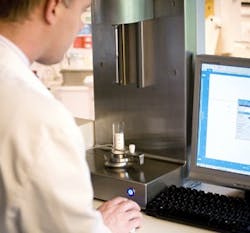Particles pose unique challenges — their size, size distribution, shape, cohesiveness and other attributes can dramatically affect how they act. So, a good grasp of particle properties often is key to successful processing. Fortunately, new research initiatives and technologies will help engineers get a much firmer grip.
One such initiative is the Engineering Research Center (ERC) for Structured Organic Particulate Systems based at Rutgers University, Piscataway, N.J. Freeman Technology, Malvern, U.K., a particle analysis and characterization expert and developer of the FT4 powder rheometer (www.ChemicalProcessing.com/articles/2009/095.html), is the latest company to join the ERC.
As part of this initiative, Freeman has installed FT4s at Rutgers, New Jersey Institute of Technology, Newark, N.J., and Purdue University, West Lafayette, Ind., to do studies on particle formation and functionalization.
There are two major goals here: to develop new methods for controlled-size particle formation that can be effectively scaled to the manufacturing level; and to control and optimize physicochemical properties of materials such as size, shape and stability through systematic functionalization. Both goals require development of requisite characterization techniques for effective measurement of critical particle properties and process monitoring.
Overall, the plan is to replace empirical methods currently used in the processing industries with a predictive framework for science-based product and process development.
Real-World Relevance
The aim of this and the company's own research, according to Reg Freeman, managing director, is to be able to describe and predict the various behavior modes of powders that occur in everyday processing.
Underpinning this is the company's conditioning process, which ensures that the packing condition of a powder sample is reproducible for testing. Repeatability (on a specific instrument and with a particular operator) and reproducibility (for any instrument/operator around the world) is very important and impossible to achieve without a conditioning process, he says.
"For example, a single light tap when placing a sample onto a work surface would cause flow energy to increase by typically 30%. Conditioning removes such an effect and also ensures that the operator's methodology for loading the sample, etc., does not affect the measured result," he notes.
The Freeman approach is to provide high reproducibility and sensitivity of measurement for all types of powder behavior. The FT4 powder rheometer (Figure 1) gives dynamic flowability measurement and determines bulk properties including compressibility, permeability and bulk density.
"The subject is challenging due to the inherent complexity of powder flow and the difficulty of predicting flow behavior in real processing environments. Much research is being done by companies and universities worldwide and we have collaborative projects with some of these as well as with other instrumentation companies like Malvern Instruments," Freeman adds.
Understanding powder behavior can be daunting but a pragmatic approach can be very effective, says Freeman. It involves making good use of process experience most companies already have.
"The process plant will have been a major investment and often is used to manufacture or process various formulations, whether making bulk material, filling bags or making tablets or capsules. Process engineers will know which materials process efficiently and which are problematic — prone to stoppages and quality issues. Our perspective is that with the FT4 it is now possible to understand why some powders process well and others do not. The benefits of this are that stoppages can be reduced or eliminated and, importantly, new formulations can have properties that suit the plant. This approach works for whole process lines as well as for individual items of plant such as a hopper, feeder or granulator."
European Initiative
BASF, Ludwigshafen, Germany, also is focusing on DEM technology. "BASF Engineering is a partner of the European research program 'PARDEM [particle DEM],' intending to validate the method and parameters for simulation purposes," notes spokeswoman Laura-Rebecca Janz.
Particles and granular solids constitute more than 75% of all raw materials used by industry, according to a European Union (EU) study. Attempts to improve processing via simulations based on classical continuum theory and standard numerical methods and design tools can't always succeed because they can't treat materials as assemblages of discrete objects.
A promising interdisciplinary alternative is DEM, which follows in detail the motion and interaction of particle assemblies. While already established in academia, the method as yet can't handle realistic particle systems of industrial relevance.
The overarching aim of the PARDEM project is to provide high quality training to a group of young researchers to foster multidisciplinary and mutli-industry use of DEM for granular processes. Part of the EU-funded Framework 7 Marie Curie Initial Training Network, it runs from 2009–2013 and currently involves 15 research projects across Europe. The EU has earmarked nearly €5 billion for research within different Marie Curie priority areas.
BASF is heading efforts in the chemical processing sector, with 10 other companies and organizations including Nestle, P&G and NASA leading work in other sectors, ranging from food to equipment manufacturing to space exploration.
The company also is very interested in research for improving reliability of shearing tests commonly used to characterize solids. To this end, it's involved in a series of ongoing round-robin trials being organized by the European Federation of Chemical Engineering that complement efforts to develop its own instruments for measuring and characterizing solids.
Online Opportunities
Meanwhile, established approaches continue to evolve. Laser diffraction technology in particular may expand its role. Such systems already are widely used in the process industries. For example, Indorama Petrochem recently chose the Mastersizer 2000 particle size analysis system from Malvern Instruments, Malvern, U.K., to provide quality control (QC) for purified terephthalic acid (PTA) production at its site in Rayong, Thailand. A similar system is at the heart of explosivity and powder-handling safety studies by process safety specialist Chilworth Technology, Plainsboro, N.J. Particle size is one of a range of properties examined by Chilworth when determining the flammability of materials and also is a critical parameter in toxicological safety testing of powders.
For Malvern, however, the future lies in online measurement.
"In terms of technologies, we are seeing laser diffraction becoming more widespread as a QC method. The question then is can we make this online?" notes Paul Kippax, product manager, diffraction products.
This has been done for more than 10 years with dry powders, he points out, but liquid flows such as suspensions and slurries present more of a challenge — although the company's Mastersizer technology can handle both in the lab. "We have developed a dilution system which extracts a sample from the process, dilutes it and then measures it by laser diffraction. Our focus now is on understanding when dilution is required and how to better control the dilution process to account for sample stability, process temperature changes and to account for the measurement requirements for laser diffraction measurements. Within the process sector, liquids represent the most rapidly growing market," says Kippax.
Within lab applications, there's also increasing focus on particle shape, which is very important in many applications such as foreign particle analysis and agglomerate/floc detection. "Here we have the FPIA 3000 for wet dispersions and the Morphologi G3 for dry dispersion; these systems are finding applications with R&D and also for root-cause analysis."
There's also a big move to nanoscale applications, for which Malvern's solution is the Zetasizer range based on dynamic light scattering/photon correlation spectroscopy (Figure 2).
The irony here is this is the first technology developed by the company back in the late 1960s and early 1970s. Dynamic light scattering systems are finding application in development of colloidal products — including sunscreens, ink jet pigments, ceramics and catalysts — where particle size typically is under 100 nm. However, the company's fastest-growing market relates to characterization of biopharmaceuticals such as proteins and peptides, particularly within academia.
"As interest continues to grow within these applications, a big challenge is to develop an online sampling system that can handle these materials. The current measurement technique (dynamic light scattering) relies on measuring the speed of Brownian motion of particles (their diffusion rate) — this is then used to calculate their hydrodynamic radius. Measurements are made in a batch measurement cell, where the sample does not flow. For process measurements the challenge will be to make measurements with flowing samples. Is an in-flow technique possible?" he wonders. The company now is investigating this. "Through this we hope to be able to meet the challenges associated with sample presentation and maintaining a barrier between the process and the measurement device as well," explains Kippax.
Other Technologies
X- Ray-fluorescence-based instrumentation also will see wider use, hopes Thermo Fisher Scientific, Ecublens, Switzerland.
The company primarily focuses on lab instruments, although some can be used in-line in specific applications such as cement manufacturing. "At the moment, organic chemicals are too complex for this technique," says Robert Hergenrader, manager, petrochemicals and analytical service labs/bulk elemental analysis. "In 10 years' time it would be great for X-ray technology to be available for on-line use. If we can get beyond the technical hurdles it would be a big leap forwards. At the moment, X-Ray systems are considered quite expensive and placed in middle to upper cost for process control equipment. But we are always looking for way to improve value to our customers," he adds.
Meanwhile, Fluid Imaging Technologies, Yarmouth, Maine, is expanding its line of FlowCAM products. These combine the capabilities of flow cytometry and microscopy and reportedly provide an order of magnitude improvement over each. The company has added the FlowCAM V-1000, an economical application-specific system with a small footprint. It suits duties, e.g., in QC labs, in which similar types of sample are continually run.
Seán Ottewell is Chemical Processing's Editor at Large. You can e-mail him at [email protected].




